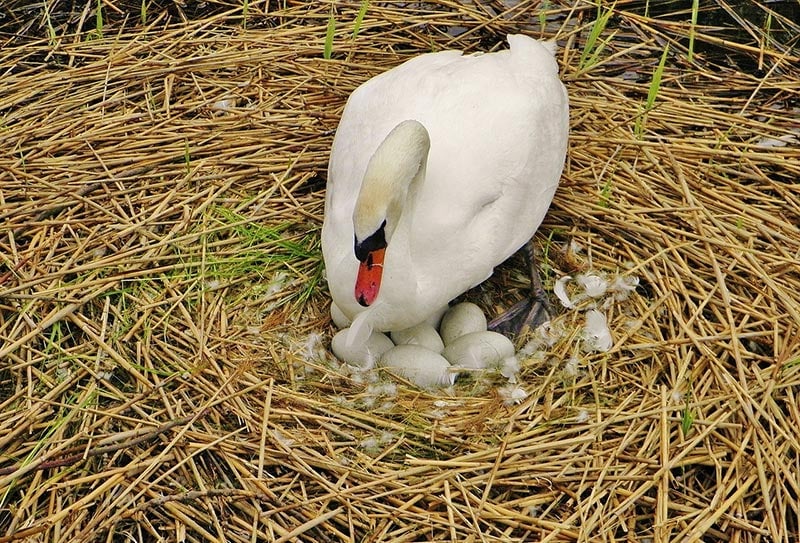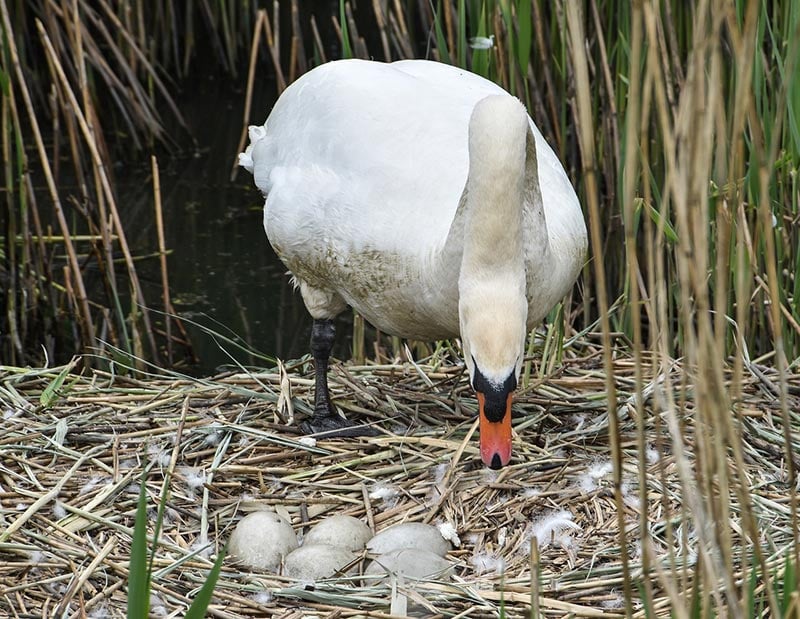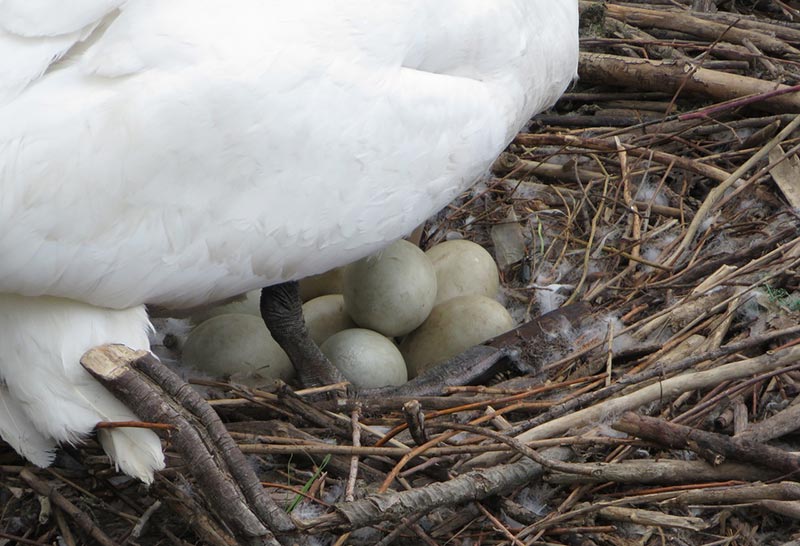When Do Swans Lay Eggs? Habits & Breeding
Last Updated on

Swans are truly marvelous creatures, and one thing that sets these birds apart from other birds is that they typically mate for life. As the whole mating and breeding process of swans is pretty interesting, some of you might want to know when swans lay eggs and how many they lay.
While they can breed once they turn 2, which is when most swans find their mate, they commonly breed at the age of 4 or 5. The female typically lays six or seven eggs, although occasionally, there can be up to 12 eggs per breeding season. The nesting starts in mid-March and can last until July.
The rest of our article will provide in-depth details about everything you should know about swan breeding and nesting habits.

Swan Nesting Habits
Once swans find their mate, they’ll likely showcase courtship behavior, and start breeding, while some swan pairs tend to have a “honeymoon phase” before their first nesting year. The nesting period starts around mid-March or April, in a safe territory chosen by the female, where the future baby swans have the best shot at survival.
Commonly, swans will nest in locations with slight elevations, primarily near the water. The nesting site needs to provide a stable food and water supply. That’s why many swans build nests on islands, in dams, or near water edges.
Both female and male swans collect grasses, algae, sedges, aquatic vegetation, and debris to make the nest. The building process takes around 2 weeks to complete. If this is not the breeding pair’s first breeding season, they might reuse their old nest if it was successful the last time, while first-time breeders build new nests.

Breeding Timeline of Swans
When swans finish nest building, which happens around mid-March, the female will start laying eggs. The female swans, also known as “pens,” typically lay six or seven eggs at 2-day intervals. However, some pens can lay up to 12 eggs per clutch.
As it takes 2 days for the egg to form before the pen lays it and ends up in the nest, it can be challenging for the pen to incubate all eggs simultaneously. If the female swan incubated one egg while waiting to lay the others, the eggs would hatch at different timelines, creating many issues.
That’s why pens lay egg2 every 2 days, without incubating them until the whole clutch gets formed. By doing that, the hatchlings will come to this world at the same time, giving them more chances to survive.
During this period, the female needs more food and nutrients than usual, so it may frequently leave the nest searching for food while the male guards the nest from predators. If the male is not around, the female covers the eggs until she finds food.
Swan Eggs
After the female lays the eggs, they’re blue-grayish, although the color shifts after the eggs spend some time in the nest. After a while, the eggs will get an olive color, and they can get scratches on the surface as the parents commonly stand on them or move them around in the nest.

Incubation
Once all eggs are in the nest, the female starts the incubation process, lasting between 35 and 41 days. During this period, the pen might leave the nest to find food, covering the eggs to protect them. The male, also known as the “cob,” protects the nest from predators and incubates the eggs if they become too cold.
While males cannot incubate eggs independently, they provide a suitable replacement if the female is absent for some time.
Cygnets
The eggs usually hatch between June and July, which is when baby swans, also known as cygnets, come to life. They remain with the pen for the first few days, after which they can leave the nest and swim on their own. Both parents take care of the young ones, helping them find food, and teaching them to learn to survive on their own.
Unfortunately, many cygnets don’t reach the first year of their life due to various issues they have through their youth. They’re frequent prey for predators, they can get hurt when learning to fly, and their lack of experience in the world can cause them to get injured on man-made structures.
However, if a cygnet lives through its first year, it will likely have a long lifespan.
- 2 weeks old: Baby swans can feed on their own, and their diet typically consists of crustaceans and aquatic insects.
- 4 to 6 weeks old: Cygnets switch to a plant-based diet, slowly leading to the feeding diet of adult swans. Their feathers develop more through this phase, and their cheeks and under plumage have full feathers.
- 9 to 10 weeks old: The feathers fully develop at this stage, and the cygnets reach half their adult size.
- 13 to 17 weeks old: At this phase, cygnets learn how to fly, and they remain with their parents for support and protection.
Once cygnets develop and their plumage changes color, the cob forces them to leave the breeding territory. Although that might seem harsh, pens need to clear the territory before the next breeding season starts.
The young remain together in groups until they turn old enough to search for their mate. Some might even visit their parents after the breeding season as they commonly have a strong sense of family and belonging.

Final Thoughts
Swans’ breeding and nesting process can be long and sometimes exhausting. The female typically lays six or more eggs starting mid-March, and it takes 2 days for each egg to develop. Once the young hatch and reach maturity, they look for their own mates to repeat the same process, and new baby swans are born.
Featured Image Credit: reverent, Pixabay
About the Author Visnja Radosavljevic
Visnja is a creative, adaptable content writer that covers various topics such as DIY, pets, home improvement, travel, gardening, and more. As a young mom and a college student, she didn’t have enough time to balance her personal and work life, so after multiple years of working a regular 9 to 5 job, she decided to pursue her passion and make a living out of it. She has been writing for a couple of years now, helping people to find valuable and interesting information online.
Related Articles:
When Were Binoculars Invented? History, Today & Future
10 Types of Hummingbirds in Arkansas (With Pictures)
8 Types of Hummingbirds in Nebraska (With Pictures)
5 Types of Hummingbirds in Idaho (With Pictures)
3 Types of Hummingbirds in Mississippi (With Pictures)
8 Types of Hummingbirds in Kansas (With Pictures)
5 Types of Hummingbirds in West Virginia (With Pictures)
5 Types of Hummingbirds in Ohio (With Pictures)
